Related Research Articles

A platformer is a sub-genre of action video games in which the core objective is to move the player character between points in an environment. Platform games are characterized by levels with uneven terrain and suspended platforms of varying height that require jumping and climbing to traverse. Other acrobatic maneuvers may factor into the gameplay, such as swinging from vines or grappling hooks, jumping off walls, gliding through the air, or bouncing from springboards or trampolines.

Virtua Cop is a 1994 light gun shooter game developed by Sega AM2 and designed by Yu Suzuki. It was originally an arcade game on the Sega Model 2 system, and was ported to the Sega Saturn in 1995 and Windows in 1996. The Saturn version included support for both the Virtua Gun and Saturn mouse, as well as a new "Training Mode" which consists of a randomly generated shooting gallery.

Space Harrier is a third-person arcade rail shooter game developed by Sega and released in 1985. It was originally conceived as a realistic military-themed game played in the third-person perspective and featuring a player-controlled fighter jet, but technical and memory restrictions resulted in Sega developer Yu Suzuki redesigning it around a jet-propelled human character in a fantasy setting. The arcade game is controlled by an analog flight stick while the deluxe arcade cabinet is a cockpit-style linear actuator motion simulator cabinet that pitches and rolls during play, for which it is referred as a taikan (体感) or "body sensation" arcade game in Japan.
Shooter video games or shooters are a subgenre of action video games where the focus is almost entirely on the defeat of the character's enemies using the weapons given to the player. Usually these weapons are firearms or some other long-range weapons, and can be used in combination with other tools such as grenades for indirect offense, armor for additional defense, or accessories such as telescopic sights to modify the behavior of the weapons. A common resource found in many shooter games is ammunition, armor or health, or upgrades which augment the player character's weapons.
Fantasy Zone is a 1986 arcade video game by Sega, and the first game in the Fantasy Zone series. It was later ported to a wide variety of consoles, including the Master System. The player controls a sentient spaceship named Opa-Opa who fights an enemy invasion in the titular group of planets. The game contains a number of features atypical of the traditional scrolling shooter. The main character, Opa-Opa, is sometimes referred to as Sega's first mascot character.
Combat flight simulators are vehicle simulation games, amateur flight simulation computer programs used to simulate military aircraft and their operations. These are distinct from dedicated flight simulators used for professional pilot and military flight training which consist of realistic physical recreations of the actual aircraft cockpit, often with a full-motion platform.
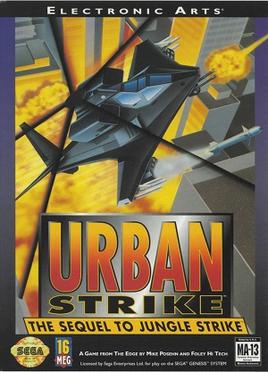
Urban Strike is a video game developed and published by Electronic Arts. It was initially released for the Sega Genesis in 1994, with ports handled by Black Pearl Software to the Super Nintendo Entertainment System and Game Gear in 1995 and to the Game Boy in 1996. It is the third game in the Strike series, after Desert Strike: Return to the Gulf and Jungle Strike.

PowerSlave, known as Exhumed in Europe and 1999 AD: Resurrection of the Pharaoh in Japan, is a first-person shooter video game developed by Lobotomy Software and published by Playmates Interactive Entertainment in North America, and BMG Interactive in Europe and Japan. It was released in North America, Europe and Japan, for the Sega Saturn, PlayStation, and MS-DOS over the course of a year from late 1996 to late 1997. On May 24, 2015, Powerslave EX, an unofficial remake of the PlayStation version appeared on GitHub. The MS-DOS version of PowerSlave was added to the GOG store on November 19, 2020.

Jungle Strike is a video game developed and published by Electronic Arts in 1993 for the Sega Genesis/Mega Drive. The game was later released on several other consoles such as the Super Nintendo Entertainment System (SNES), and an upgraded version was made for DOS computers. The Amiga conversion was the responsibility of Ocean Software while the SNES and PC DOS versions were that of Gremlin Interactive, and the portable console versions were of Black Pearl Software. It is the direct sequel to Desert Strike and is the second installment in the Strike series. The game is a helicopter-based shoot 'em up, mixing action and strategy. The plot concerns two villains intent on destroying Washington, D.C. The player must use the helicopter and occasionally other vehicles to thwart their plans.

Black Dawn is a helicopter-combat simulation, published by Virgin Interactive Entertainment. It was released on the Sony PlayStation and the Sega Saturn in 1996.

Shining the Holy Ark (シャイニング・ザ・ホーリィアーク) is a first person role-playing video game released in 1997 for the Sega Saturn. It is a part of Sega's Shining series of video games, and marked a new direction for the series, utilizing polygons as well as sprites for the visuals and a story targeted more specifically towards an adult audience. It introduced the saga of the Vandals and the Innovators, abandoning the saga of the Devil Kings which was followed by the previous installments of the series.
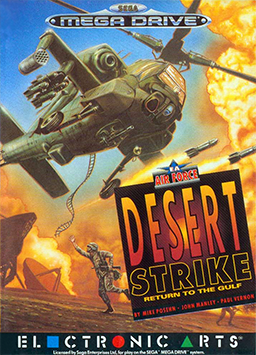
Desert Strike: Return to the Gulf is a shoot 'em up video game released by Electronic Arts (EA) in March 1992 for the Sega Genesis. The game was released on several other formats such as the Super Nintendo Entertainment System, including a much upgraded version for the Amiga home computer. The game was inspired by the Gulf War and depicts a conflict between an insane Middle Eastern dictator, General Kilbaba, and the United States. The player controls an Apache helicopter and attempts to destroy enemy weapons and installations, rescue hostages and capture enemy personnel, while managing supplies of fuel and ammunition.
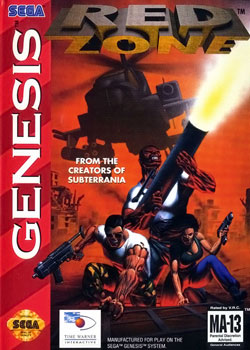
Red Zone is a 1994 shoot 'em up, developed by Zyrinx and published by Time Warner Interactive for the Sega Genesis. The player switches between piloting a helicopter and walking around on foot, both from a top-down view.
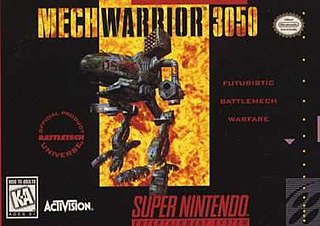
MechWarrior 3050, also known as BattleTech in its original Sega Genesis release and in Japan as BattleTech 3050 (バトルテック3050), is a 1994 mech-based video game developed by Malibu. The first BattleTech based game to be released for the Sega Genesis, it was later ported to the Super Nintendo by Activision as MechWarrior 3050. The Super Nintendo game was localized and published in Japan by Ask Group.
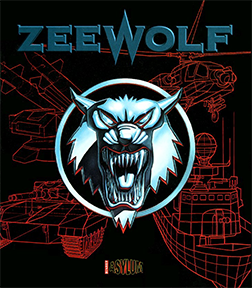
Zeewolf is a single-player 3D shoot 'em up computer game released for the Amiga platform in November 1994 by Binary Asylum. A Sega Mega Drive version was planned but never released. The player is tasked with flying a helicopter gunship over 32 combat missions. The game has a similar design and appearance to the earlier Zarch created by David Braben.

Virtual Hydlide is an action role-playing game for the Sega Saturn console, developed by T&E Soft, published by Sega in Europe and Japan, and Atlus Software in North America. It is a remake of the original Hydlide, the first game in the series, but incorporated full 3D graphics and a player character digitized from a live actor. On release, it received mixed reviews, with praise for its graphics, 3D environments and music, while receiving criticism for its gameplay.

Firestorm: Thunderhawk 2, known as Thunderstrike 2 in North America, is a 1995 combat flight simulation video game developed and published by Core Design for PlayStation, Sega Saturn and MS-DOS. It is the sequel to Thunderhawk AH-73M.

Soviet Strike is a helicopter-based shooter game developed and published by Electronic Arts for the PlayStation in 1996 and the Sega Saturn in 1997. The game is a sequel to the Strike games which began on the Sega Genesis with Desert Strike: Return to the Gulf. Soviet Strike is the series' first installment for a 32-bit console and was first conceived as 32-bit Strike. Early on, it was intended for the 3DO console, before development changed to the PlayStation.

Nuclear Strike is a shooter video game developed and published by Electronic Arts for the PlayStation in 1997. The game is the sequel to Soviet Strike and the fifth installment in the Strike series, which began with Desert Strike on the Sega Genesis. The Soviet Strike development team also created Nuclear Strike. EA released a Windows port the same year; THQ developed and in 1999 published a Nintendo 64 version called Nuclear Strike 64.

Black Fire is a 1995 combat flight simulation video game developed by NovaLogic, published in North America by Sega and in Japan and Europe by Virgin Interactive Entertainment for the Sega Saturn.
References
- ↑ "Sega CD". GamePro . No. 83. IDG. August 1995. p. 38.
- ↑ "Register a Trademark Online. Search for a Trademark Online".
- ↑ Next Generation 21 (September 1996), p.38.
- ↑ "Palomar Pictures teams with Electronic Arts to produce full-motion video for upcoming "Nuclear Strike" game". ebworld.com. May 13, 1997. Archived from the original on July 14, 1997. Retrieved November 3, 2019.